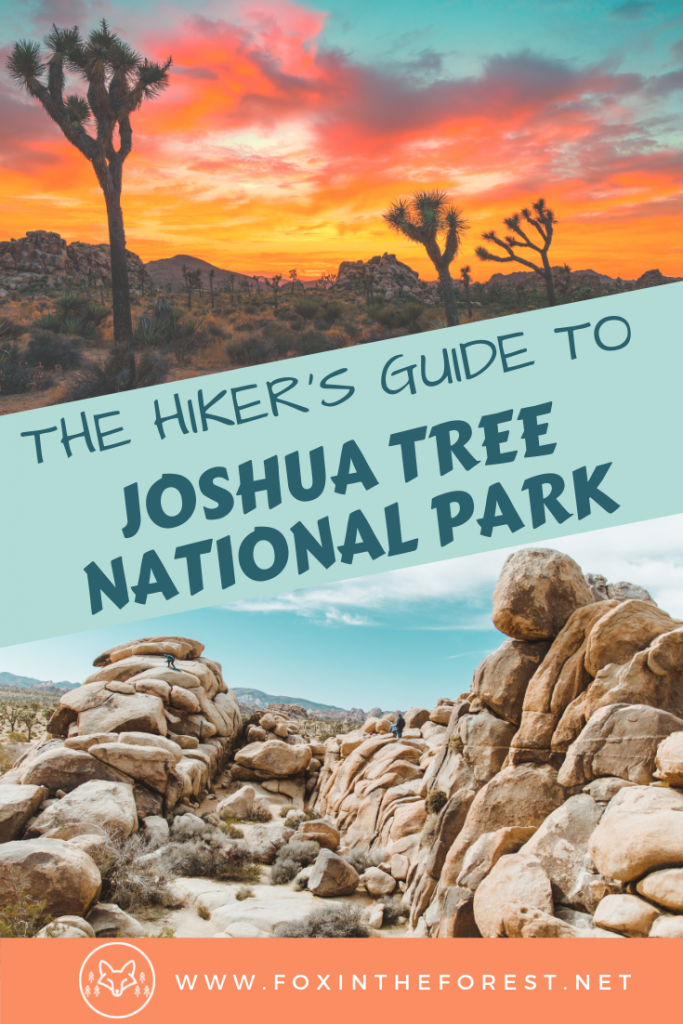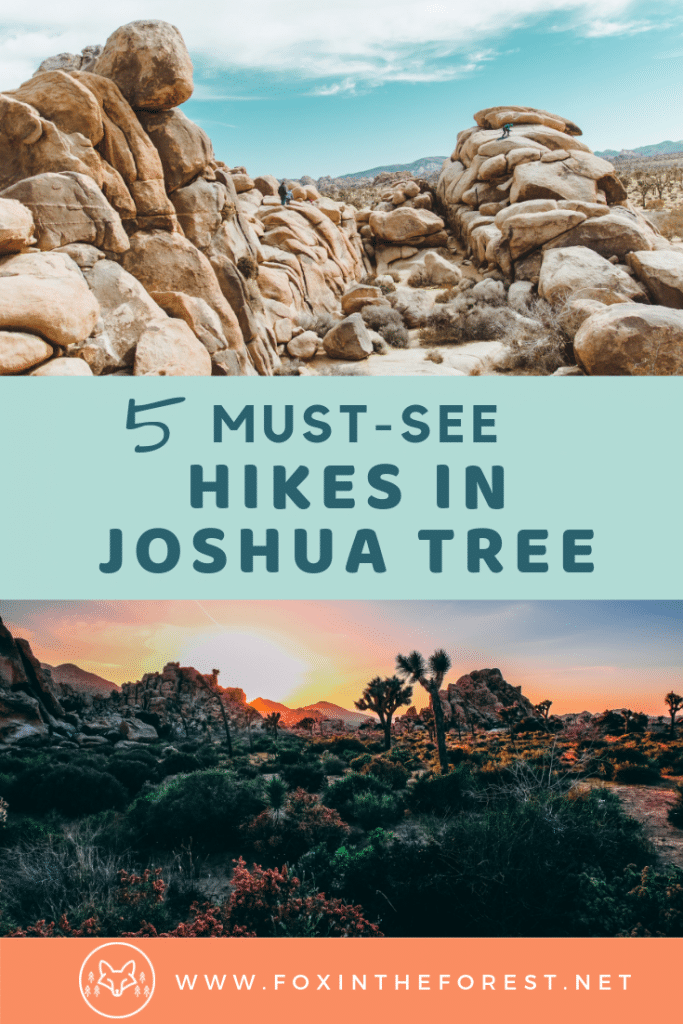Last Updated on January 10, 2024 by foxintheforest
Surround yourself with stunning rock formations and unique wildlife at Joshua Tree National Park. Explore the park on foot with this list of the best hikes in Joshua Tree National Park.
The unique blend of high and low desert environments brings incredible scenery, unique wildlife, and plenty of strange looking trees called Joshua Trees, which give the park its namesake.
In fact, one of the best things to do in Joshua Tree National Park is hit the trails! And trust me, you don’t want to miss out on these amazing hikes in one of the prettiest national parks in the US.
Get the inside scoop from an expert hiker on how to enjoy the best trails in Joshua Tree.
About this Guide to the Best Hikes in Joshua Tree National Park
When it comes to hiking in the desert, Joshua Tree National Park has a lot to offer. I enlisted a top-notch hiking blogger to give you the inside scoop on the best hikes in Joshua Tree. In this guide, you’ll find:
- Information about visiting Joshua Tree National Park
- An in-depth look at the best trails in Joshua Tree
- Each Joshua tree hiking trail description includes information on the difficulty, mileage, gain, location, and points of interest.
- What to pack for your Joshua Tree hike
- Tips for hiking in the desert
- Navigating and additional planning resources
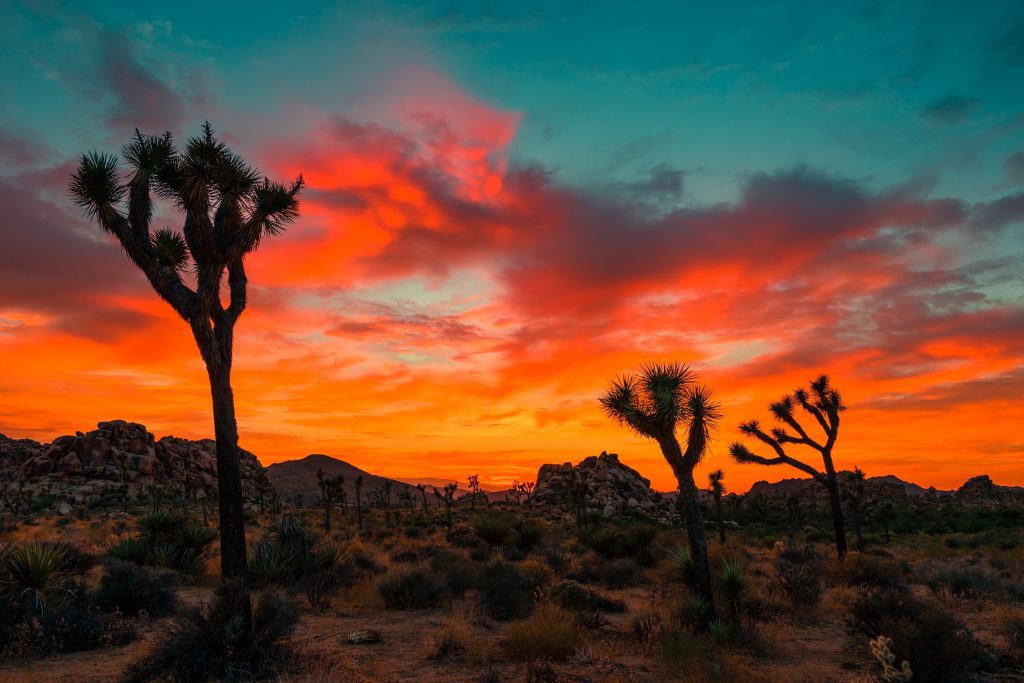
Practical Information About Hiking in Joshua Tree National Park
In order to get into Joshua Tree National Park, you’ll pay $25 per vehicle. If you plan on visiting for multiple days, I’d recommend picking up the America the Beautiful Annual Park‘s Pass for $80.
The pass lets you enter any national landmark, recreation area or national park for free. It’s a screaming deal, especially if you’re planning a desert road trip to hit up multiple national parks.
In addition, keep in mind that parking can be limited. Always obey the parking requirements in Joshua Tree National park. Start early or hike late to avoid the heat of the day.
The Best Hikes in Joshua Tree National Park
This list of the best hikes in Joshua Tree gives you an in-depth description of each hiking trail, along with all the details you need for a successful hike.
Each of these hikes takes you to some stunning desert scenery. Be sure to pack your camera and sunscreen to soak up all that desert magic. Make the most of your trip with the best trails in Joshua Tree.
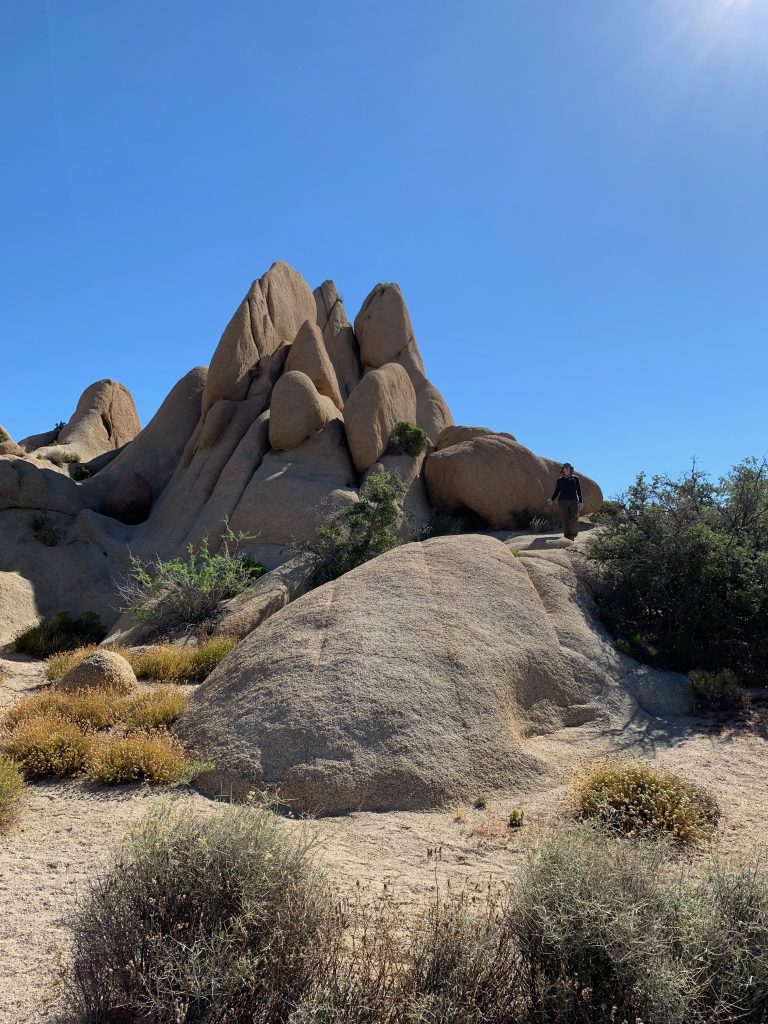
Skull Rock
Distance: 1.7 miles
Elevation: 160 feet
Type: Loop
Difficulty: Easy
While this might be a short hike by some standards, it’s packed with lots of iconic Joshua Tree sites and scenery, making it a must-see Joshua Tree hiking trail. It’s the perfect hike for families, beginners or those who want to take it easy and learn more about the areas flora and fauna.
You can start this loop hike from the nearby Skull Rock parking area or from within the Jumbo Rocks campground. As you walk along the well-defined path you will see boulder piles, desert washes and pass by the hike’s namesake Skull Rock. Over time wind and water have shaped this large granite monolith into the shape of a human skull.
Keep an eye out for nature trail signs along the way that will tell you more about the area’s plants and animals. If you’re lucky you might even catch a kangaroo rat hopping among the boulders as you walk.
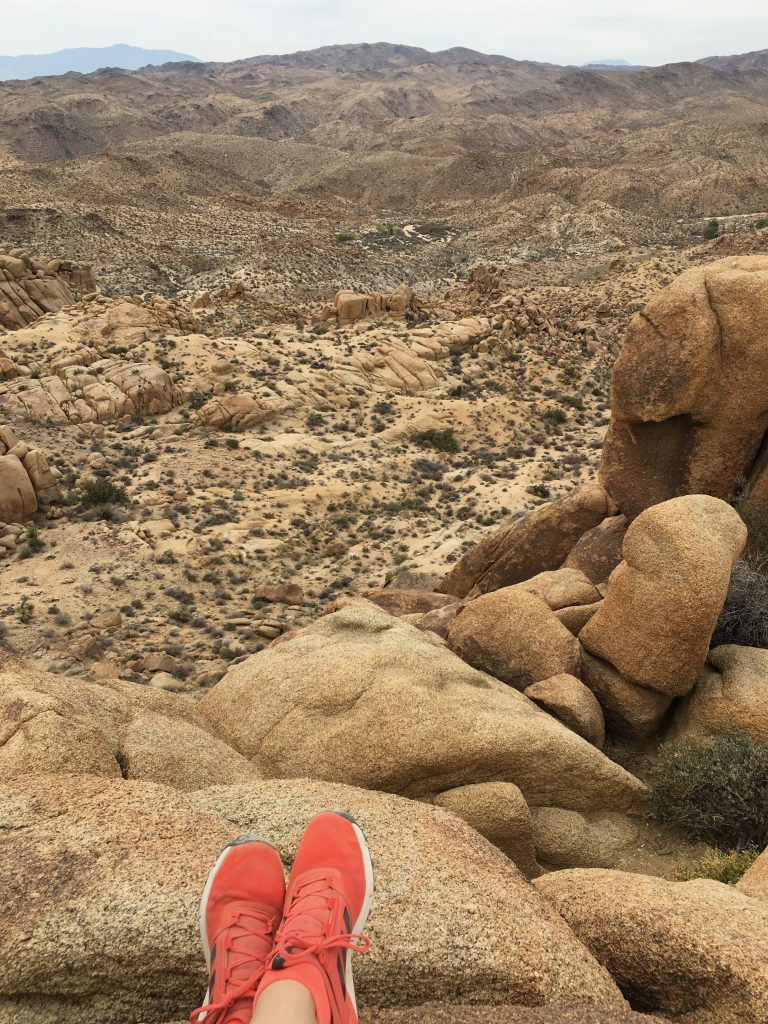
Mastodon Peak
Distance: 3 miles
Elevation: 375 feet
Type: Loop
Difficulty: Moderate
You begin this loop hike near the Cottonwood Visitors Center at the South end of the park. There is ample parking here and plenty of signage to get you on your way. As you approach the beginning of the trail you’ll see a magical clump of palm trees, an oasis really.
Head down the paved path through the trees and enjoy the shade. Make sure to read the signs and find out more about the native peoples who once lived in this area, it’s pretty fascinating.
As you continue along you’ll start a gentle progressive climb up stone and sand steps. The sand is fairly compressed, but will still add a little extra resistance to your hike.
As you continue to climb you’ll start to be able to take in more and more of your surroundings. At the top of this climb, you will see the base of Mastodon Peak.
A tenth of a mile scramble will take you to the top where you can enjoy 360-views of the park, making it one of the best hikes in Joshua tree with a view.
I recommend approaching this climb from the backside of the rock pile for easier climbing. On a good day, you will also be able to see the Salton Sea off in the distance from this point. This is a good spot to stop for a little snack or a water break before heading onward.
Once you climb down the peak you will continue on the trail and pass an old gold mine. It’s not too much to look at now, but it was operational up until 1971. From this point you will continue along desert washes, heading downward through loose sand and gravel. In another few tenths of a mile, you will find yourself back at the parking lot where you began.
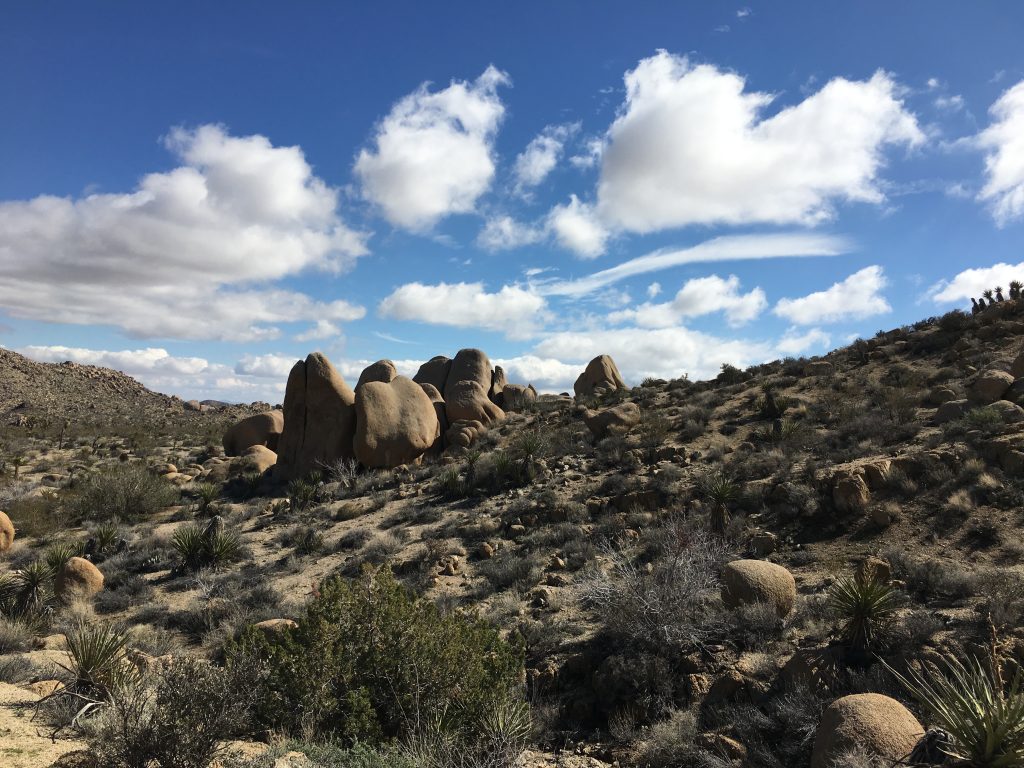
Lost Horse Mine
Distance: 4 miles
Elevation: 550 feet
Type: Out and back
Difficulty: Moderate
Unlike many of the other mines in Joshua Tree, Lost Horse Mine was quite productive, yielding approximately 10,000 ounces of gold and 16,000 ounces of silver. Today it is not operational, however, it is very well preserved thanks to the National Parks Service.
It’s worth warning you now that there is no shade to be found on this trail, so I advise starting early or heading out in the evening light. The hike begins at the parking lot at the end of Lost Horse Road which is clearly marked on any park map.
You begin with a gentle climb towards the nearby mountains, but not to worry, it’s not too steep. As you continue hiking take note of the desert plants, specifically the iconic yucca trees. Continue walking upwards and you will begin to see the valley below as well as the mine up ahead of you.
The mine itself is fenced in for safety, but take some time and walk around to check it out from all angles. Once you’ve taken in the mine you can head back the way you came, or take a short hike to the hill above. From this point, you can see sweeping views of the park and all the many layers of surrounding mountains.
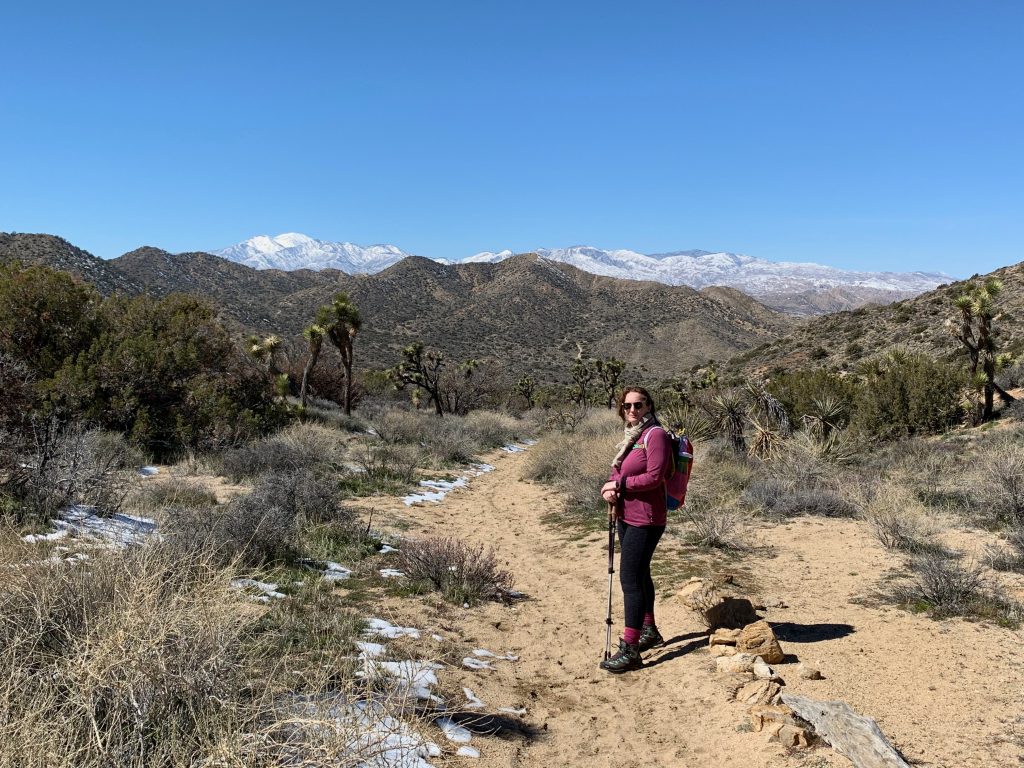
West Side Loop
Distance: 4.7 miles
Elevation: 785 feet
Type: Loop
Difficulty: Moderate
To get to this hike you need to enter Black Rock Campground in the northeast corner of the park. The trail begins east of site #30 at the back of the campground. The higher elevation of this part of the park is the perfect climate for yucca trees, juniper, pinyon pines and wildflowers in the spring.
I recommend taking this loop hike in the clockwise direction, starting on the High View Nature Trail which has a junction with the West Side Loop at 0.1 miles in. Head uphill briefly and then downhill, watching out for the often snow-capped San Gorgonio off in the distance. As you continue around the loop you will walk through a wash and then begin a steep climb towards a rolling ridge.
At 2.5 miles you will begin a descent, bringing you through a large grove of Joshua trees. This was by far my favorite part of the hike. The sheer number of Joshua trees in one small area was beautiful.
At this point you will start heading back towards the campground where you started, continue following signs for the West Side Loop and you will be back at the parking lot.
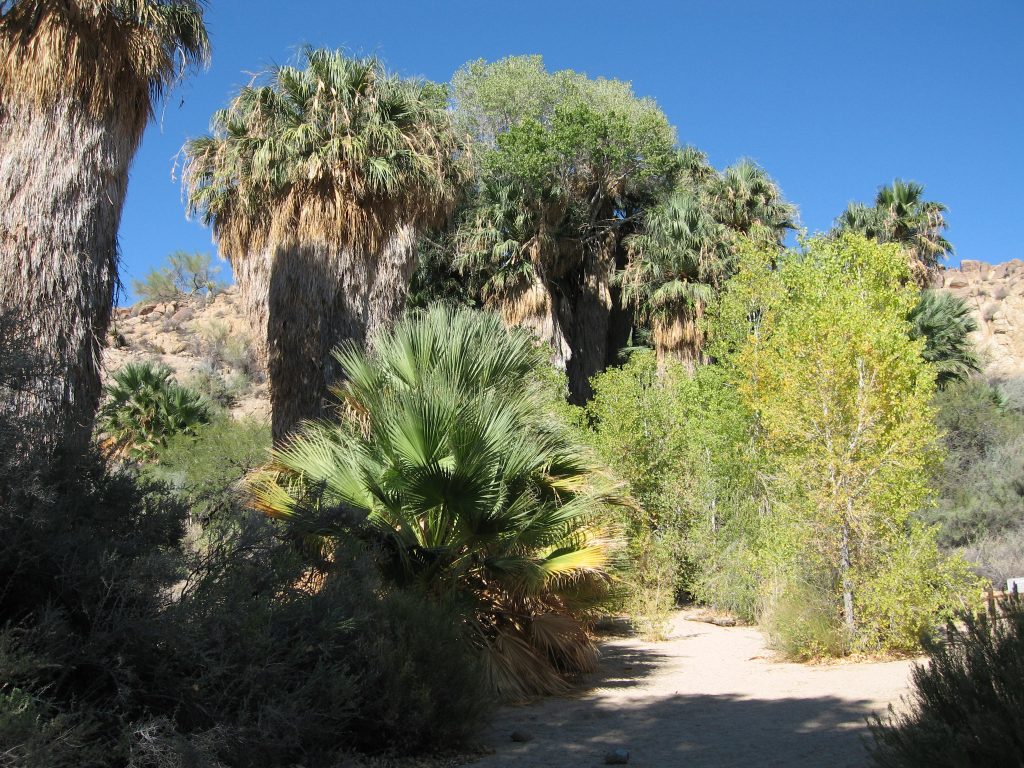
Lost Palms Oasis
Distance: 7.5 miles
Elevation: 500 feet
Type: Out and back
Difficulty: Challenging
This out-and-back hike can be extended to include the scramble of Mastodon Peak described earlier. The trailhead is located just past the road that leads to Cottonwood Campground. There is a small turnaround and plenty of parking along the side of the road.
Start your hike at the Cottonwood Springs Oasis, a small but beautiful clump of native fan palms. Head through the shady palms to the next 3.5 miles of desert hills. Along the way, you will see plenty of rock piles, monoliths, native plants and trail stairways built by the park service. Keep a lookout for the ocotillo cactus which have bright red flowers in the spring.
You will pass signs for Mastodon Peak Mine, but to stay on this trail follow signs for Lost Palms Oasis. This portion of the hike will give you a real sense of the desert, leading you through sand and gravel, between boulders, and at times scrambling.
Near the turnaround point, you will be able to see the Lost Palms Oasis you walked through at the beginning of this hike from above, as well as a second clump of palms called Dike Springs. If you’re feeling energized you can scramble downward towards the palms, or simply turn around and head back the way you came.
What to Pack for Hiking in Joshua Tree National Park
Before you hit the trail, it’s important to be prepared for hiking in a desert environment. First, you’ll want to make sure you’ve got the basics so be sure to pack the Ten Essentials first. On top of the Ten Essentials you’ll also want to consider the following:
- Extra sun protection. The desert lacks shade, so bring a wide-brimmed hat, sunscreen or UV-protected shirt or sleeves, and sunglasses.
- Proper Footwear. You’ll want to wear hiking shoes (boots will feel too hot) with non-cotton socks to prevent blisters. Consider wearing socks that go above the ankle to help protect you from a cactus encounter. Learn more about how to select proper hiking footwear.
- Extra First Aid Kit Items. Pack a powdered electrolyte drink (I love Nuun), tweezers for cacti encounters, anti-itch cream/Benedryl/or similar product in case you have a bad reaction to cacti.
- Extra water. Plan on drinking double your normal intake. Remember, you cannot filter and use water inside the park, so come prepared! Remember, water is heavy.
- Salty snacks. You’ll want to replenish your salt supply and not overhydrate. Think salty chips, salty trail mixes, beef jerky, and other salty treats.
- Consider a personal swamp cooler. Take a long-sleeved cotton shirt or bandana and soak it in cold water before you head out. Wring out the excess water, fold, and store in a zipped baggie. During the hottest part of the day, put on the damp shirt or bandana. Voila! The water will evaporate in the dry environment, have you feeling cool in a jiffy.
- A headlamp, especially if you plan on hiking the evening.
- Bathroom kit. Complete with small shovel, TP, a baggie for used toilet paper, and hand sanitizer. Or be a super-steward and pack it out with a WAG Bag.
- A camera with a zoom lens or your phone.
General Tips for Hiking in Joshua Tree
Again, hiking in the desert takes a few special skills. Keep the following in mind while you hit all the amazing hiking trails in Joshua Tree National Park.
- Beat the heat. Hike in the early hours of the day or later in the evening to avoid the brutal mid-day sun.
- Leave it wild. Don’t touch the wildlife. In fact, it is super-illegal to harass wildlife in Joshua Tree National Park, especially the tortoise. You can kill them if you approach them, as they urinate to keep away unwanted company, which causes them to lose precious water. Use your zoom lens instead.
- Seek shade. Shade is hard to come by, so take note of the sun’s position while you are hiking. Find a shady spot to rest if you can, but don’t trample wild areas to do it.
- Be kind. Say hello to fellow hikers.
Navigating Joshua Tree Hiking Trails
Navigating your way through the best Joshua Tree hikes, or any desert hiking trail, takes a bit of extra knowledge. First, watch your step! There are prickly cacti around every bend. These cacti will latch on detach themselves in clumps and stick to your clothing and body. They also itch when you remove them.
Pro Tip: Always make sure your first aid kit has a pair of tweezers.
Avoid cactus by sticking to marked trails and following ranger signs and instructions. Although most of the Joshua Tree National Park hiking trails are well marked, always be sure to carry a map, compass, and a digital GPS of the trail you would like to hike.
Keep in mind, water is scarce and it is illegal throughout the park to utilize found water sources (too many endangered animals, like the desert tortoise, rely on these water sources to survive) so come prepared.
Hiking Responsibly in the Desert
Before you head on any hike, it’s really important to understand the basics of Leave No Trace. With the rise in popularity of national parks, there has been a tremendous strain on park resources, so it’s up to you to do your part.
First, always leave it better than you found it, this means packing out ALL of your trash (including food scraps, wrappers, cigarette butts, feminine products, and toilet paper).
For TP, cover a zippable baggie in duct tape and sprinkle in some baking soda (for the smell). Make this your icky trash bag and keep this with you until you can properly dispose of it.
Always follow closure signs, stay on the trail, and respect the spaces you are traveling in. When it comes time to use the bathroom if there isn’t one nearby, carefully step 70 adult steps from the trail and any water sources then pee on a rock, since animals can destroy vegetation in search of your salty urine.
If you have to go number two and there isn’t an outhouse around, dig a hole 6 to 8 inches deep. You get an A-plus if you use a bag to pack out your waste. Poop does not decompose in desert environments, so be considerate of this fact when you use the loo.
Summing Up the Best Joshua Tree Hikes
These are just five of the hikes you can explore inside Joshua Tree National Park. Each one shows off the landscape, plants, and animals particular to that area of the park.
If you’re spending more than a couple of days in Joshua Tree make sure to check out Keyes View or head to Sky’s the Limit Observatory and Nature Center for some stargazing.
Meet Kristi of Indoorsy Camper
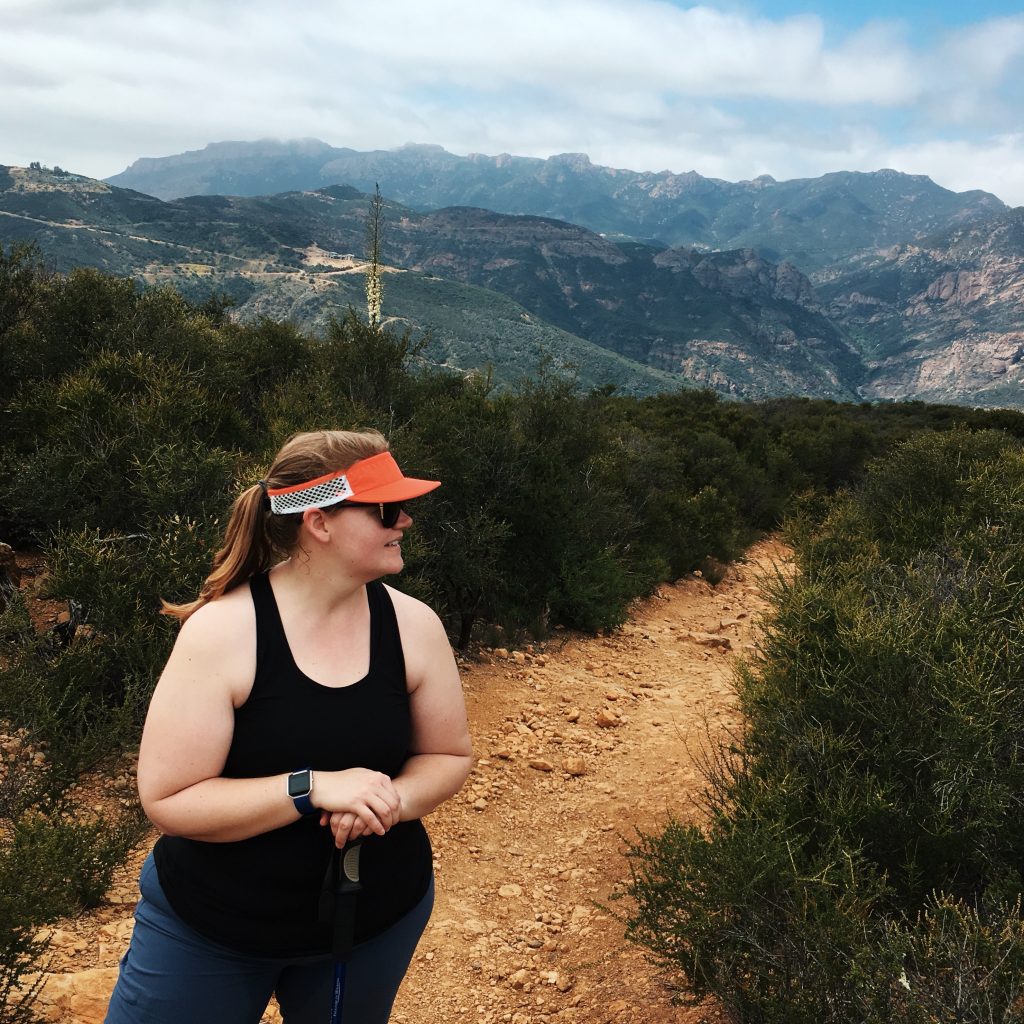
Kristi Westberg is a writer, camper, hiker, knitter, and bookworm living in Pasadena, CA. She is the creator of Indoorsy Camper a blog where she writes about the outdoors from a beginner’s perspective because she’s a newbie too.
She believes that all bodies are strong and capable of experiencing the outdoors and that they should have fun while doing it. Her hope is that by chronicling her mishaps and successes she will inspire other indoorsy types to have the courage to get outside.
You can follow Kristi and her adventures over on her blog Indoorsy Camper and on her Instagram page.
